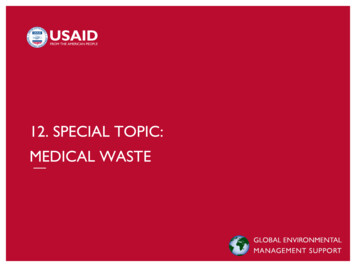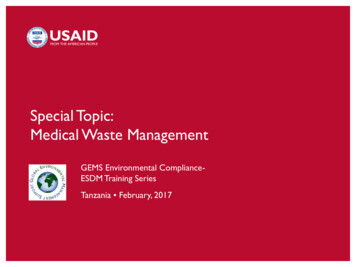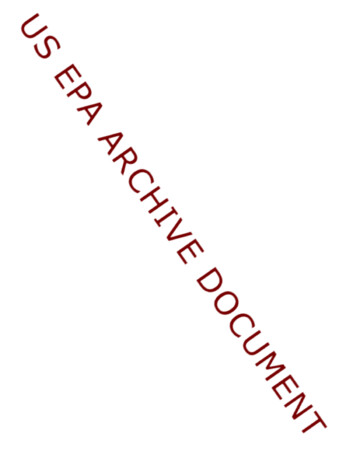
Transcription
12. SPECIAL TOPIC:MEDICAL WASTE
SPECIAL TOPIC: MEDICAL WASTELearning Outcomes1.2.3.4.5/21/2018Review the different types of medical wasteSensitize to the risks of improper disposalUnderstand medical waste management proceduresDiscuss environmental compliance and safeguards for effectivewaste managementSpecial Topic: Medical Waste76
TWO MAJOR TYPES OF MEDICALWASTE General solid waste‒ Similar to domestic waste‒ Includes paper, plastic, packaging,food prep‒ No patient contact‒ 75 – 90% of healthcare facilitywaste is hazardous Hazardous waste5/21/2018Special Topic: Medical Waste77
HAZARDOUS WASTE Hazardous Waste includes:‒ Infectious waste (except sharps andwaste from patients with highlyinfectious diseases)‒ Small quantities of chemicals andpharmaceuticals‒ Non-recyclable pressurizedcontainers Highly Hazardous waste is aseparate category5/21/2018Special Topic: Medical Waste78
HIGHLY HAZARDOUS WASTE Highly Hazardous includes:‒‒‒‒SharpsHighly infectious non-sharp wasteStools from cholera patientsBodily fluids of patients with highlyinfectious diseases‒ Large quantities of expired or unwantedpharmaceuticals and hazardous chemicalsand radioactive wastes‒ Genotoxic wastes (affecting geneticcomposition and multiple generations)‒ Teratogenic wastes (affectingdevelopment of the exposed individual)5/21/2018Special Topic: Medical Waste79
WHAT ARE THERISKS? Physical injury‒ Cuts, punctures (e.g., fromsharps) Disease transmission‒ Greatest and most immediatethreat‒ HIV/AIDS, hepatitis B & C Water supplycontamination‒ Infectious stools or bodily fluids Chemical and toxic‒ Pharmaceuticals‒ Heavy metals (mercury,cadmium)5/21/2018Special Topic: Medical Waste80
MANDATORY ENVIRONMENTAL REVIEW Reg. 216 applies!‒ Establishment or rehabilitation ofhealth centers or clinics‒ Training or technical assistanceto health care providers orinstitutions—”health systemstrengthening” Environmental analysis (EA orIEE) prepared to determinenature and extent of risks EA/IEE conditions specifymitigation and monitoringcriteria for medical wastemanagement‒ Segregation and disposal‒ Use of personal protectiveequipment (PPE); training5/21/2018Special Topic: Medical Waste81
EFFECTIVE MEDICALWASTEMANAGEMENT Segregation & Disposal: Nonhazardous solid waste‒ Treat same as “domestic waste”‒ Reduces waste quantity, cost, riskfrom and to scavengers andworkers‒ Manage as close to point ofgeneration as possible‒ Disposal options include landfilling,incineration‒ Do not incinerate plastic, PVC orpackaging—incineration producesdioxins, furans etc.5/21/2018Special Topic: Medical Waste82
EFFECTIVEMEDICAL WASTEMANAGEMENT Segregation &Disposal: Sharps‒ Use rigid, puncture- and leakproof containers; ideally red‒ Marked as sharps‒ Monitored‒ Treatment and disposaloptions include: Autoclaved/ sterilized/encapsulated/incinerated (with noplastic products) Properly disposedlandfill, encapsulation5/21/2018Special Topic: Medical Waste83
EFFECTIVE MEDICAL WASTE MANAGEMENT Segregation & Disposal:Infectious Waste‒ Double bagged‒ Hard exterior container (can,plastic bucket) with a lid‒ Marked‒ Yellow/red packaging if possible5/21/2018Special Topic: Medical Waste84
WASTES AND APPROPRIATERECEPTACLES5/21/2018Special Topic: Medical Waste85
TRAINING AND PLANNING Proper training of medicalpersonnel and staff– Use of personal protectiveequipment (PPE); gloves, masks,gumboots, etc.– Waste managementrequirements and procedures Medical Waste ManagementPlan Budgets and resources– Appropriate management anddisposal techniques and costs– Transportation needs?– Human capacity– Environmental monitoring andreporting5/21/2018Special Topic: Medical Waste86
RESOURCES: SECTORENVIRONMENTAL GUIDELINES Provides “plainlanguage” guidancefor sound design andmanagement Identifies typical risksand impacts andrecommendsmitigation andmonitoringapproaches5/21/2018Special Topic: Medical Waste87
HAZARDOUS WASTE. 5/21/2018 Special Topic: Medical Waste 78 Hazardous Waste includes: ‒ Infectious waste (except sharps and waste from patients with highly infectious diseases) ‒ Small quantities of chemicals and pharmaceuticals ‒ Non-recyclable pressurized containers Highly Hazardous waste is a separate category










